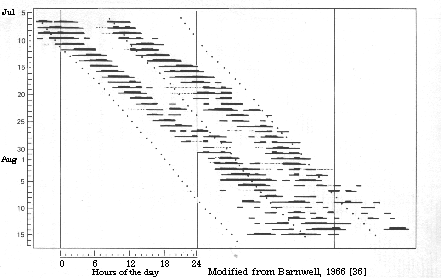
OTHER RHYTHMS...Tidal
 Another type of rhythm seen in organisms is that imposed by the ebb and
flow of the tides. To understand this rhythm, one must recall some earth
science. The earth rotates on its axis in a counterclockwise fashion and
the moon circles the earth in the same direction. In one earth rotation (24
hr.) relative to the sun, the moon has moved so that the earth rotates an
additional 13 degrees to "catch up" with the moon[35]. As a
consequence moonrise to moonrise is 24 hours and 51 minutes. During this time
span, 2 tidal inundations occur at approximately 12.4 hours apart. The ebb
and flow of the tide imposes alternating fluctuations in temperature,
pressure, food supply, mechanical agitation, and salinity on the organisms
in the intertidal zone. The tide, therefore, often molds their physiological
and behavioral responses into tidal rhythms[35]. These rhythms
persist even when the organisms are put in the laboratory environment.
Another type of rhythm seen in organisms is that imposed by the ebb and
flow of the tides. To understand this rhythm, one must recall some earth
science. The earth rotates on its axis in a counterclockwise fashion and
the moon circles the earth in the same direction. In one earth rotation (24
hr.) relative to the sun, the moon has moved so that the earth rotates an
additional 13 degrees to "catch up" with the moon[35]. As a
consequence moonrise to moonrise is 24 hours and 51 minutes. During this time
span, 2 tidal inundations occur at approximately 12.4 hours apart. The ebb
and flow of the tide imposes alternating fluctuations in temperature,
pressure, food supply, mechanical agitation, and salinity on the organisms
in the intertidal zone. The tide, therefore, often molds their physiological
and behavioral responses into tidal rhythms[35]. These rhythms
persist even when the organisms are put in the laboratory environment.
As early as 1903, Gamble and Keeble described a tidal rhythm in a
flatworm on the coast of Brittany (See review by 35). The worms migrate to the surface
during daytime low tides, but burrow in the sand during high tide and at
night. Photosynthetic algae live within the tissues of these worms and it
is to the worms' advantage to get as much sunshine as possible. They
burrow during high tide to prevent dislodgement. This rhythm persists in
the lab when the worms are kept in constant light, but not in constant
dark.
 Visitors to the beach are familiar with the low tide scurrying of
fiddler crabs as they feed, court, and threaten one another. As high tide
approaches, they return to their burrows. Do these crabs simply burrow as
they notice the water coming, or do they have an endogenous rhythm
synchronized with the tides? In a study of fiddler crabs Barnwell found
that crabs showed tidal locomotor rhythms lasting almost a month in
constant light in the laboratory (See review by 35).
Visitors to the beach are familiar with the low tide scurrying of
fiddler crabs as they feed, court, and threaten one another. As high tide
approaches, they return to their burrows. Do these crabs simply burrow as
they notice the water coming, or do they have an endogenous rhythm
synchronized with the tides? In a study of fiddler crabs Barnwell found
that crabs showed tidal locomotor rhythms lasting almost a month in
constant light in the laboratory (See review by 35).
The graph shows the
activity of a male fiddler crab in a natural light/dark cycle.
Tidal activity rhythms have also been observed in other marine
invertebrates such as isopods, pink shrimp, midges, snails, and mollusks.
Tidal rhythms have also been observed in fish. The shanny is a fish which
lives under stones in pools during low tide and feeds during high tide. In
the laboratory, the tidal rhythm persists in either constant darkness or
light[35]. In 1958, Brown observed that Australian reef
herons flew from rookeries out to sea to feed on animals exposed during
low tide. Because the low tide could not be seen from the nesting area, he
suspected that the birds possessed a lunar clock [35].

Accessibility statement
 Visitors to the beach are familiar with the low tide scurrying of
fiddler crabs as they feed, court, and threaten one another. As high tide
approaches, they return to their burrows. Do these crabs simply burrow as
they notice the water coming, or do they have an endogenous rhythm
synchronized with the tides? In a study of fiddler crabs Barnwell found
that crabs showed tidal locomotor rhythms lasting almost a month in
constant light in the laboratory (See review by 35).
Visitors to the beach are familiar with the low tide scurrying of
fiddler crabs as they feed, court, and threaten one another. As high tide
approaches, they return to their burrows. Do these crabs simply burrow as
they notice the water coming, or do they have an endogenous rhythm
synchronized with the tides? In a study of fiddler crabs Barnwell found
that crabs showed tidal locomotor rhythms lasting almost a month in
constant light in the laboratory (See review by 35).


 Another type of rhythm seen in organisms is that imposed by the ebb and
flow of the tides. To understand this rhythm, one must recall some earth
science. The earth rotates on its axis in a counterclockwise fashion and
the moon circles the earth in the same direction. In one earth rotation (24
hr.) relative to the sun, the moon has moved so that the earth rotates an
additional 13 degrees to "catch up" with the moon[35]. As a
consequence moonrise to moonrise is 24 hours and 51 minutes. During this time
span, 2 tidal inundations occur at approximately 12.4 hours apart. The ebb
and flow of the tide imposes alternating fluctuations in temperature,
pressure, food supply, mechanical agitation, and salinity on the organisms
in the intertidal zone. The tide, therefore, often molds their physiological
and behavioral responses into tidal rhythms[35]. These rhythms
persist even when the organisms are put in the laboratory environment.
Another type of rhythm seen in organisms is that imposed by the ebb and
flow of the tides. To understand this rhythm, one must recall some earth
science. The earth rotates on its axis in a counterclockwise fashion and
the moon circles the earth in the same direction. In one earth rotation (24
hr.) relative to the sun, the moon has moved so that the earth rotates an
additional 13 degrees to "catch up" with the moon[35]. As a
consequence moonrise to moonrise is 24 hours and 51 minutes. During this time
span, 2 tidal inundations occur at approximately 12.4 hours apart. The ebb
and flow of the tide imposes alternating fluctuations in temperature,
pressure, food supply, mechanical agitation, and salinity on the organisms
in the intertidal zone. The tide, therefore, often molds their physiological
and behavioral responses into tidal rhythms[35]. These rhythms
persist even when the organisms are put in the laboratory environment.